《植物育种学》课程教学大纲(植物育种原理教学大纲,中英文)
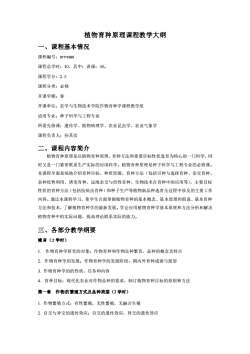
植物育种原理课程教学大纲一、课程基本情况课程编号:01111990课程总学时:40,其中:讲课:40。课程学分:2.5课程分类:必修开课学期:春开课单位:农学与生物技术学院作物育种学课程教学组适用专业:种子科学与工程专业所需先修课:遗传学、植物病理学、农业昆虫学、农业气象学课程负责人:孙其信二、课程内容简介植物育种原理是以植物育种原理、育种方法和重要目标性状选育为核心的一门科学,同时义是一门紧密联系生产实际的应用科学。植物育种原理是种子科学与工程专业的必修课。本课程全面系统地介绍育种目标、种质资源、育种方法(包括引种与选择育种、杂交育种、杂种优势利用、诱变育种、远缘杂交与倍性育种、生物技术在育种中的应用等)、主要目标性状的育种方法(包括抗病虫育种)和种子生产等植物新品种选育全过程中涉及的主要工作内容。通过本课程学习,使学生合面掌握植物育种的基本概念、基本原理和假说、基本育种方法和技术,了解植物育种学的最新发展。学会应用植物育种学基本原理和方法分析和解决植物育种中的实际问题,提高理论联系实际的能力。三、各部分教学纲要绪言(2学时)1.作物育种学研究的对象:作物育种和作物良种繁育,品种的概念及特点2.作物育种学的发展:作物育种学的发展阶段,国内外育种成就与展望3.作物育种学的的性质、任务和内容4.育种目标:现代化农业对作物品种的要求,制订植物育种目标的原则和方法第一章作物的繁殖方式及品种类型(2学时)1.作物繁殖方式:有性繁殖,无性繁殖,无融合生殖2.自交与异交的遗传效应:自交的遗传效应,异交的遗传效应
植物育种原理课程教学大纲 一、课程基本情况 课程编号:01111990 课程总学时:40,其中:讲课:40。 课程学分:2.5 课程分类:必修 开课学期:春 开课单位:农学与生物技术学院作物育种学课程教学组 适用专业:种子科学与工程专业 所需先修课:遗传学、植物病理学、农业昆虫学、农业气象学 课程负责人:孙其信 二、课程内容简介 植物育种原理是以植物育种原理、育种方法和重要目标性状选育为核心的一门科学,同 时又是一门紧密联系生产实际的应用科学。植物育种原理是种子科学与工程专业的必修课。 本课程全面系统地介绍育种目标、种质资源、育种方法(包括引种与选择育种、杂交育种、 杂种优势利用、诱变育种、远缘杂交与倍性育种、生物技术在育种中的应用等)、主要目标 性状的育种方法(包括抗病虫育种)和种子生产等植物新品种选育全过程中涉及的主要工作 内容。通过本课程学习,使学生合面掌握植物育种的基本概念、基本原理和假说、基本育种 方法和技术,了解植物育种学的最新发展。学会应用植物育种学基本原理和方法分析和解决 植物育种中的实际问题,提高理论联系实际的能力。 三、各部分教学纲要 绪言(2 学时) 1. 作物育种学研究的对象:作物育种和作物良种繁育,品种的概念及特点 2.作物育种学的发展:作物育种学的发展阶段,国内外育种成就与展望 3. 作物育种学的的性质、任务和内容 4.育种目标:现代化农业对作物品种的要求,制订植物育种目标的原则和方法 第一章 作物的繁殖方式及品种类型(2 学时) 1. 作物繁殖方式:有性繁殖,无性繁殖,无融合生殖 2. 自交与异交的遗传效应:自交的遗传效应,异交的遗传效应
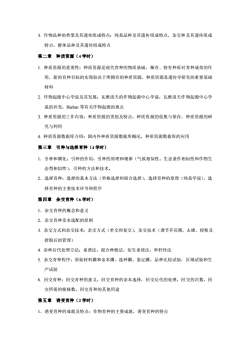
3.作物品种的类型及其遗传组成特点:纯系品种及其遗传组成特点,杂交种及其遗传组成特点,群体品种及其遗传组成特点第二章种质资源(4学时)1.种质资源的重要性:种质资源是现代育种的物质基础,稀有、特有种质对育种成效的作用,新的育种目标的实现取决于所拥有的种质资源,种质资源是遗传学研究的重要基础材料2.作物起源中心学说及其发展:瓦维洛夫的作物起源中心学说,瓦维洛夫作物起源中心学说的补充,Harlan等有关作物起源的观点3.种质资源的工作内容:种质资源的类别及特点,种质资源的收集与保存,种质资源的研究与利用4.种质资源数据库介绍:国内外种质资源数据库概况,种质资源数据库的应用第三章引种与选择育种(4学时)1.引种和驯化:引种的作用,引种的原理和规律(气候相似性、生态条件相似性和作物生态型相似性),引种的方法和技术。2.选择育种:选择的基本方法(单株选择和混合选择),选择育种的原理(纯系学说),选择育种的主要技术环节和程序第四章杂交育种(6学时)1.杂交育种的概念和意义2.杂交育种亲本选配的原则3.杂交方式和杂交技术:杂交方式(单交和复交),杂交技术(调节开花期、去雄、授粉及授粉后的管理)4.杂种后代处理方法:系谱法,混合种植法,衍生系统法,单籽传法5.杂交育种程序:原始材料圃和亲本圃,选种圃,鉴定圃,品种比较试验,区域试验和生产试验6.回交育种:回交育种的意义,回交育种的亲本选择,回交后代的处理,回交的次数,回交所需的植株数,回交育种的其他用途第五章诱变育种(2学时)1.诱变育种的成就及特点:作物育种的主要成就,诱变育种的特点
3. 作物品种的类型及其遗传组成特点:纯系品种及其遗传组成特点,杂交种及其遗传组成 特点,群体品种及其遗传组成特点 第二章 种质资源(4 学时) 1. 种质资源的重要性:种质资源是现代育种的物质基础,稀有、特有种质对育种成效的作 用,新的育种目标的实现取决于所拥有的种质资源,种质资源是遗传学研究的重要基础 材料 2. 作物起源中心学说及其发展:瓦维洛夫的作物起源中心学说,瓦维洛夫作物起源中心学 说的补充,Harlan 等有关作物起源的观点 3. 种质资源的工作内容:种质资源的类别及特点,种质资源的收集与保存,种质资源的研 究与利用 4. 种质资源数据库介绍:国内外种质资源数据库概况,种质资源数据库的应用 第三章 引种与选择育种(4 学时) 1.引种和驯化:引种的作用,引种的原理和规律(气候相似性、生态条件相似性和作物生 态型相似性),引种的方法和技术。 2.选择育种:选择的基本方法(单株选择和混合选择),选择育种的原理(纯系学说),选 择育种的主要技术环节和程序 第四章 杂交育种(6 学时) 1.杂交育种的概念和意义 2.杂交育种亲本选配的原则 3. 杂交方式和杂交技术:杂交方式(单交和复交),杂交技术(调节开花期、去雄、授粉及 授粉后的管理) 4. 杂种后代处理方法:系谱法,混合种植法,衍生系统法,单籽传法 5. 杂交育种程序:原始材料圃和亲本圃,选种圃,鉴定圃,品种比较试验,区域试验和生 产试验 6. 回交育种:回交育种的意义,回交育种的亲本选择,回交后代的处理,回交的次数,回 交所需的植株数,回交育种的其他用途 第五章 诱变育种(2 学时) 1.诱变育种的成就及特点:作物育种的主要成就,诱变育种的特点
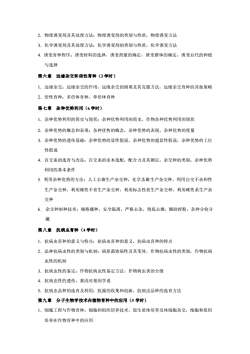
2.物理诱变剂及其处理方法:物理诱变剂的类别与性质,物理诱变方法3.化学诱变剂及其处理方法:化学诱变剂的类别与性质,化学诱变方法4.诱变育种程序:诱变材料的选择,诱变剂量的确定,诱变群体的确定,诱变后代的种植与选择第六章远缘杂交和倍性育种(3学时)1.远缘杂交:远缘杂交的作用,远缘杂交的困难及其克服方法,远缘杂交育种的其他策略2.倍性育种:多倍体育种,单倍体育种第七章杂种优势利用(6学时)1.杂种优势利用的简史与现状:杂种优势利用的简史,作物杂种优势利用的现状2.杂种优势的概念和表现:杂种优势的概念,杂种优势的表现,杂种优势的度量3.杂种优势的遗传基础:杂种优势的显性假说,杂种优势的超显性假说,杂种优势的上位性假说4.自交系的选育与改良:自交系的亲本选配,配合力及其测定,杂交种的类别,杂种优势利用的基本条件5.利用杂种优势的方法:人工去雄生产杂交种,化学杀雄生产杂交种,利用自交不亲和性生产杂交种,利用雄性不育生产杂交种,利用标志性状生产杂交种,利用雌性系生产杂交种6.杂交种制种技术:规格播种,安全隔离,严格去杂,彻底去雄,辅助授粉,杂种分收分藏第八章抗病虫育种(4学时)1.抗病虫育种的意义与特点:抗病虫育种的意义,抗病虫育种的特点2.品种抗病虫性的类别与机制:病原菌致病性及其变异,作物抗病虫性的类别,作物抗病虫性的机制3.抗病虫性的鉴定:作物抗病虫性鉴定方法,作物病虫害的分级4.抗病虫性的遗传,基因对基因学说5.抗病虫品种的选育及利用:抗源的收集和创新,抗病虫品种的选育方法第九章分子生物学技术在植物育种中的应用(5学时)1.细胞工程与作物育种:细胞和组织培养技术,原生质体培养及体细胞杂交,细胞和组织培养在作物育种中的应用
2.物理诱变剂及其处理方法:物理诱变剂的类别与性质,物理诱变方法 3.化学诱变剂及其处理方法:化学诱变剂的类别与性质,化学诱变方法 4. 诱变育种程序:诱变材料的选择,诱变剂量的确定,诱变群体的确定,诱变后代的种植 与选择 第六章 远缘杂交和倍性育种(3 学时) 1.远缘杂交:远缘杂交的作用,远缘杂交的困难及其克服方法,远缘杂交育种的其他策略 2.倍性育种:多倍体育种,单倍体育种 第七章 杂种优势利用(6 学时) 1.杂种优势利用的简史与现状:杂种优势利用的简史,作物杂种优势利用的现状 2.杂种优势的概念和表现:杂种优势的概念,杂种优势的表现,杂种优势的度量 3.杂种优势的遗传基础:杂种优势的显性假说,杂种优势的超显性假说,杂种优势的上位 性假说 4.自交系的选育与改良:自交系的亲本选配,配合力及其测定,杂交种的类别,杂种优势 利用的基本条件 5. 利用杂种优势的方法:人工去雄生产杂交种,化学杀雄生产杂交种,利用自交不亲和性 生产杂交种,利用雄性不育生产杂交种,利用标志性状生产杂交种,利用雌性系生产杂 交种 6. 杂交种制种技术:规格播种,安全隔离,严格去杂,彻底去雄,辅助授粉,杂种分收分 藏 第八章 抗病虫育种(4 学时) 1.抗病虫育种的意义与特点:抗病虫育种的意义,抗病虫育种的特点 2.品种抗病虫性的类别与机制:病原菌致病性及其变异,作物抗病虫性的类别,作物抗病 虫性的机制 3.抗病虫性的鉴定:作物抗病虫性鉴定方法,作物病虫害的分级 4.抗病虫性的遗传,基因对基因学说 5.抗病虫品种的选育及利用:抗源的收集和创新,抗病虫品种的选育方法 第九章 分子生物学技术在植物育种中的应用(5 学时) 1.细胞工程与作物育种:细胞和组织培养技术,原生质体培养及体细胞杂交,细胞和组织 培养在作物育种中的应用
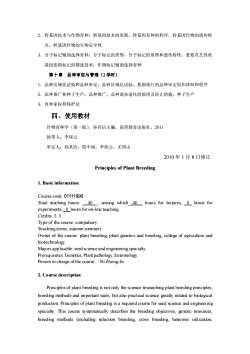
2.转基因技术与作物育种:转基因技术的发展,转基因育种的程序,转基因作物的遗传特点,转基因作物的生物安全性3.分子标记辅助选择育种:分子标记的类型,分子标记的原理和遗传特性,重要农艺性状基因连锁标记的筛选技术,作物标记辅助选择育种第十章品种审定与管理(2学时)1:品种区域化试验和品种审定:品种区域化试验,我国现行的品种审定组织体制和程序2.品种推广和种子生产:品种推广,品种混杂退化的原因及防止措施,种子生产3.育种家权利保护法四、使用教材作物育种学(第一版),孙其信主编,高等教育出版社,2011执笔人:李保云审定人:孙其信,倪中福,李保云,尤明山2010年1月8日修订Principles of Plant Breeding1. Basic informationCourse code:01111990Total teachinghours:40,among which40hours forlectures,_hours forexperiments,_0_hours foron-line teachingCredits:2.5Type ofthe course:compulsoryTeachingterms:autumnsummer)Owner of the course: plant breeding, plant genetics and breeding, college of agriculture andbiotechnologyMajorsapplicable:seedscienceandengineeringspecialtyPrerequisites: Genetics, Plant pathology,EntomologyPerson in chargeofthecourse:NiZhong-fu2.CoursedescriptionPrinciples of plant breeding is not only the science researching plant breeding principlesbreedingmethods and important traits, but alsopractical science greatly related to biologicalproduction Principles of plant breeding is a required course for seed science and engineeringspecialty.This course systematicallydescribes the breeding objectives,genetic resourcesbreeding methods (including selection breeding, cross breeding,heterosis utilization
2.转基因技术与作物育种:转基因技术的发展,转基因育种的程序,转基因作物的遗传特 点,转基因作物的生物安全性 3.分子标记辅助选择育种:分子标记的类型,分子标记的原理和遗传特性,重要农艺性状 基因连锁标记的筛选技术,作物标记辅助选择育种 第十章 品种审定与管理(2 学时) 1.品种区域化试验和品种审定:品种区域化试验,我国现行的品种审定组织体制和程序 2.品种推广和种子生产:品种推广,品种混杂退化的原因及防止措施,种子生产 3.育种家权利保护法 四、使用教材 作物育种学(第一版),孙其信主编,高等教育出版社,2011 执笔人:李保云 审定人:孙其信,倪中福,李保云,尤明山 2010 年 1 月 8 日修订 Principles of Plant Breeding 1. Basic information Course code: 01111990 Total teaching hours: _ 40 _, among which_40 _ hours for lectures, _0_ hours for experiments, _0_hours for on-line teaching. Credits: 2.5 Type of the course: compulsory Teaching terms: autumn summer) Owner of the course: plant breeding, plant genetics and breeding, college of agriculture and biotechnology Majors applicable: seed science and engineering specialty Prerequisites: Genetics, Plant pathology, Entomology Person in charge of the course: Ni Zhong-fu 2. Course description Principles of plant breeding is not only the science researching plant breeding principles, breeding methods and important traits, but also practical science greatly related to biological production. Principles of plant breeding is a required course for seed science and engineering specialty. This course systematically describes the breeding objectives, genetic resources, breeding methods (including selection breeding, cross breeding, heterosis utilization
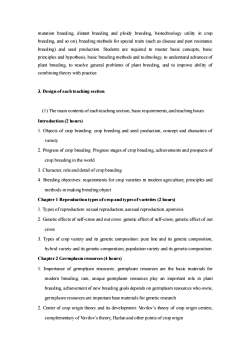
mutation breeding,distant breeding and ploidy breeding,biotechnology utility in cropbreeding, and so on), breeding methods for special traits (such as disease and pest resistancebreeding)and seedproduction.Students arerequired to masterbasic concepts,basicprinciples and hypothesis, basic breeding methods and technology, to understand advances ofplant breeding,to resolve general problems of plant breeding, and to improve ability ofcombining theory with practice3. Design of each teaching section(1)Themain contents ofeachteachingsection, basicrequirements,andteaching hoursIntroduction (2 hours)1. Objects of crop breeding: crop breeding and seed production, concept and characters ofvariety2. Progress of crop breeding: Progress stages of crop breeding, achievements and prospects ofcrop breeding in the world3.Character,roleanddetail ofcropbreeding4. Breeding objectives: requirements for crop varieties in moden agriculture, principles andmethods inmakingbreedingobjectChapter1 Reproduction types ofcropand types ofvarieties (2 hours)1.Types ofreproduction: sexual reproduction,asexual reproduction,apomixis2.Genetic effectsof self-cross and out cross:genetic effectof self-cross,geneticeffectofoutcross3.Types of crop variety and its genetic composition: pure line and its genetic composition,hybrid variety and its genetic composition, population variety and its genetic compositionChapter2Germplasmresources(4hours)I.Importanceofgemplasm resources:gemplasm resourcesarethebasic materials formodern breedingrare, unique gemplasm resources play an important role in plantbreeding, achievement of new breeding goals depends on germplasm resources who owns,germplasm resources are important basematerialsfor genetic research2. Center of crop origin theory and its development: Vavilov's theory of crop origin centers,complementary of Vavilov's theory, Harlan and other points of crop origin
mutation breeding, distant breeding and ploidy breeding, biotechnology utility in crop breeding, and so on), breeding methods for special traits (such as disease and pest resistance breeding) and seed production. Students are required to master basic concepts, basic principles and hypothesis, basic breeding methods and technology, to understand advances of plant breeding, to resolve general problems of plant breeding, and to improve ability of combining theory with practice. 3. Design of each teaching section (1) The main contents of each teaching section, basic requirements, and teaching hours Introduction (2 hours) 1. Objects of crop breeding: crop breeding and seed production, concept and characters of variety 2. Progress of crop breeding: Progress stages of crop breeding, achievements and prospects of crop breeding in the world 3. Character, role and detail of crop breeding 4. Breeding objectives: requirements for crop varieties in modern agriculture, principles and methods in making breeding object Chapter 1 Reproduction types of crop and types of varieties (2 hours) 1. Types of reproduction: sexual reproduction, asexual reproduction, apomixis 2. Genetic effects of self-cross and out cross: genetic effect of self-cross, genetic effect of out cross 3. Types of crop variety and its genetic composition: pure line and its genetic composition, hybrid variety and its genetic composition, population variety and its genetic composition Chapter 2 Germplasm resources (4 hours) 1. Importance of germplasm resources: germplasm resources are the basic materials for modern breeding, rare, unique germplasm resources play an important role in plant breeding, achievement of new breeding goals depends on germplasm resources who owns, germplasm resources are important base materials for genetic research 2. Center of crop origin theory and its development: Vavilov’s theory of crop origin centers, complementary of Vavilov’s theory, Harlan and other points of crop origin
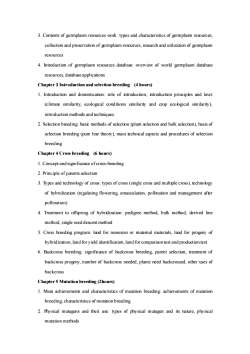
3.Contents of germplasm resources work:types and characteristics of germplasm resources,collection and preservation of germplasm resources,research and utilization of gemplasmresources4.Introduction of germplasm resources database:overview of world germplasm databaseresources,databaseapplicationsChapter3Introduction and selectionbreeding(4 hours)1. Introduction and domestication: role of introduction, introduction principles and laws(climate similarity, ecological conditions similarity and crop ecological similarity),introductionmethodsandtechniques.2. Selection breeding: basic methods of selection (plant selection and bulk selection), basis ofselection breeding (pure line theory), main technical aspects and procedures of selectionbreedingChapter4Cross breeding(6 hours)1.Concept andsignificance ofcross-breeding2. Principle of parents selection3. Types and technology of cross: types of cross (single cross and multiple cross), technologyof hybridization (regulating flowering,emasculation, pollination and management afterpollination)4. Treatment to offspring of hybridization: pedigree method, bulk method, derived linemethod, single seed descent method5.Cross breeding program: land for resources or matemal materials, land for progeny ofhybridization, land for yield identification,land for comparison test and production test6. Backcross breeding: significance of backcross breeding, parent selection, treatment ofbackcrossprogeny,numberofbackcrossneeded,plantsneedbackcrossed,otherusesofbackcrossChapter5 Mutation breeding (2hours)1. Main achievements and characteristics of mutation breeding: achievements of mutationbreeding,characteristicsofmutationbreeding2. Physical mutagens and their use: types of physical mutagen and its nature, physicalmutationmethods
3. Contents of germplasm resources work: types and characteristics of germplasm resources, collection and preservation of germplasm resources, research and utilization of germplasm resources 4. Introduction of germplasm resources database: overview of world germplasm database resources, database applications Chapter 3 Introduction and selection breeding (4 hours) 1. Introduction and domestication: role of introduction, introduction principles and laws (climate similarity, ecological conditions similarity and crop ecological similarity), introduction methods and techniques. 2. Selection breeding: basic methods of selection (plant selection and bulk selection), basis of selection breeding (pure line theory), main technical aspects and procedures of selection breeding Chapter 4 Cross breeding (6 hours) 1. Concept and significance of cross-breeding 2. Principle of parents selection 3. Types and technology of cross: types of cross (single cross and multiple cross), technology of hybridization (regulating flowering, emasculation, pollination and management after pollination) 4. Treatment to offspring of hybridization: pedigree method, bulk method, derived line method, single seed descent method 5. Cross breeding program: land for resources or maternal materials, land for progeny of hybridization, land for yield identification, land for comparison test and production test 6. Backcross breeding: significance of backcross breeding, parent selection, treatment of backcross progeny, number of backcross needed, plants need backcrossed, other uses of backcross Chapter 5 Mutation breeding (2hours) 1. Main achievements and characteristics of mutation breeding: achievements of mutation breeding, characteristics of mutation breeding 2. Physical mutagens and their use: types of physical mutagen and its nature, physical mutation methods
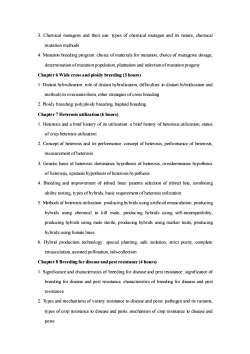
3.Chemical mutagens and their use: types of chemical mutagen and its nature, chemicalmutationmethods4. Mutation breeding program: choice of materials for mutation, choice of mutagenic dosage,determinationofmutationpopulation,plantation andselectionofmutation progenyChapter 6 Wide cross and ploidy breeding (3 hours)1.Distant hybridization:role of distanthybridization,difficulties indistant hybridization andmethodsto overcomethem,other strategies ofcross breeding2.Ploidy breeding: polyploidy breeding, haploid breedingChapter7Heterosis utilization (6 hours)1. Heterosis and a brief history of its utilization: a brief history of heterosis utilization, statusof crop heterosis utilization2. Concept of heterosis and its performance: concept of heterosis, perfomance of heterosis,measurementofheterosis3. Genetic basis of heterosis: dominance hypothesis of heterosis, overdominance hypothesisof heterosis, epistasis hypothesis ofheterosis hypothesis4. Breeding and improvement of inbred lines: parents selection of inbred line, combiningability testing,types ofhybrids, basic requirement ofheterosis utilization5.Methods of heterosis utilization:producing hybrids using artificial emasculation, producinghybrids using chemical to kill male, producing hybrids using self-incompatibilityproducing hybrids using male sterile, producing hybrids using marker traits, producinghybrids using female lines6. Hybrid production technology: special planting, safe isolation, strict purity, completeemasculation,assistedpollination,sub-collectionChapter8Breedingfor diseaseand pest resistance (4hours)1. Significance and characteristics of breeding for disease and pest resistance: significance ofbreeding for disease and pest resistance, characteristics of breeding for disease and pestresistance2. Types and mechanisms of variety resistance to disease and pests: pathogen and its variants.types of crop resistance to disease and pests, mechanism of crop resistance to disease andpests
3. Chemical mutagens and their use: types of chemical mutagen and its nature, chemical mutation methods 4. Mutation breeding program: choice of materials for mutation, choice of mutagenic dosage, determination of mutation population, plantation and selection of mutation progeny Chapter 6 Wide cross and ploidy breeding (3 hours) 1. Distant hybridization: role of distant hybridization, difficulties in distant hybridization and methods to overcome them, other strategies of cross breeding 2. Ploidy breeding: polyploidy breeding, haploid breeding Chapter 7 Heterosis utilization (6 hours) 1. Heterosis and a brief history of its utilization: a brief history of heterosis utilization, status of crop heterosis utilization 2. Concept of heterosis and its performance: concept of heterosis, performance of heterosis, measurement of heterosis 3. Genetic basis of heterosis: dominance hypothesis of heterosis, overdominance hypothesis of heterosis, epistasis hypothesis of heterosis hypothesis 4. Breeding and improvement of inbred lines: parents selection of inbred line, combining ability testing, types of hybrids, basic requirement of heterosis utilization 5. Methods of heterosis utilization: producing hybrids using artificial emasculation, producing hybrids using chemical to kill male, producing hybrids using self-incompatibility, producing hybrids using male sterile, producing hybrids using marker traits, producing hybrids using female lines 6. Hybrid production technology: special planting, safe isolation, strict purity, complete emasculation, assisted pollination, sub-collection Chapter 8 Breeding for disease and pest resistance (4 hours) 1. Significance and characteristics of breeding for disease and pest resistance: significance of breeding for disease and pest resistance, characteristics of breeding for disease and pest resistance 2. Types and mechanisms of variety resistance to disease and pests: pathogen and its variants, types of crop resistance to disease and pests, mechanism of crop resistance to disease and pests
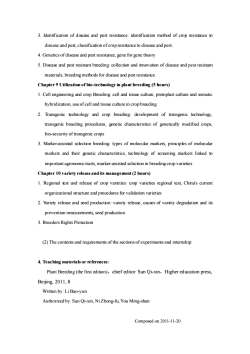
3. Identification of disease and pest resistance: identification method of crop resistance todisease and pest, classification of crop resistance to disease and pest.4.Genetics of disease and pest resistance, gene for gene theory5.Disease and pest resistant breeding:collection and innovation of disease and pest resistantmaterials, breeding methods for disease and pest resistanceChapter9Utilizationof bio-technologyinplantbreeding (5hours)1.Cell engineering and crop Breeding:cell and tissue culture,protoplast culture and somatichybridization, use ofcell and tissue culture in crop breeding2.Transgenic technology and crop breedingdevelopment of transgenic technology,transgenic breeding procedures, genetic characteristics of genetically modified crops,bio-security oftransgenic crops3. Marker-assisted selection breeding: types of molecular markers, principles of molecularmarkers and their genetic characteristics, technology of screening markers linked toimportantagronomictraits,marker-assistedselectioninbreedingcropvarietiesChapter 10 variety release and its management (2 hours)1. Regional test and release of crop varieties: crop varieties regional test, China's currentorganizational structureand proceduresforvalidation varieties2. Variety release and seed production: variety release, causes of variety degradation and itsprevention measurements, seed production3. Breeders Rights Protection(2) The contents and requirements of the sections ofexperiments and internship4. Teaching materials or references:Plant Breeding (the first edition), chief editor: Sun Qi-xin, Higher education press,Beijing,2011,8Written by: Li Bao-yunAuthorized by: Sun Qi-xin, Ni Zhong-fu, You Ming-shanComposed on 2011-11-20
3. Identification of disease and pest resistance: identification method of crop resistance to disease and pest, classification of crop resistance to disease and pest. 4. Genetics of disease and pest resistance, gene for gene theory 5. Disease and pest resistant breeding: collection and innovation of disease and pest resistant materials, breeding methods for disease and pest resistance. Chapter 9 Utilization of bio-technology in plant breeding (5 hours) 1. Cell engineering and crop Breeding: cell and tissue culture, protoplast culture and somatic hybridization, use of cell and tissue culture in crop breeding 2. Transgenic technology and crop breeding: development of transgenic technology, transgenic breeding procedures, genetic characteristics of genetically modified crops, bio-security of transgenic crops 3. Marker-assisted selection breeding: types of molecular markers, principles of molecular markers and their genetic characteristics, technology of screening markers linked to important agronomic traits, marker-assisted selection in breeding crop varieties Chapter 10 variety release and its management (2 hours) 1. Regional test and release of crop varieties: crop varieties regional test, China's current organizational structure and procedures for validation varieties 2. Variety release and seed production: variety release, causes of variety degradation and its prevention measurements, seed production 3. Breeders Rights Protection (2) The contents and requirements of the sections of experiments and internship: 4. Teaching materials or references: Plant Breeding (the first edition),chief editor: Sun Qi-xin,Higher education press, Beijing, 2011, 8 Written by: Li Bao-yun Authorized by: Sun Qi-xin, Ni Zhong-fu, You Ming-shan Composed on 2011-11-20
按次数下载不扣除下载券;
注册用户24小时内重复下载只扣除一次;
顺序:VIP每日次数-->可用次数-->下载券;
- 《植物营养学》课程教学资源(PPT课件)第七章 养分的吸收.ppt
- 《植物营养学》课程教学资源(PPT课件)第五章 有益元素.ppt
- 《植物营养学》课程教学资源(PPT课件)第十一章 植物对逆境土壤的适应性.ppt
- 《植物营养学》课程教学资源(PPT课件)第十章 植物营养的遗传特性与改良.ppt
- 《植物营养学》课程教学资源(PPT课件)第九章 矿质营养与植物生长、产量和品质的关系.ppt
- 《植物营养学》课程教学资源(PPT课件)第八章 养分的运输和分配.ppt
- 《植物营养学》课程教学资源(PPT课件)第六章 土壤养分生物有效性.ppt
- 《植物营养学》课程教学资源(PPT课件)第四章 微量营养元素 4.2 硼 B.ppt
- 《植物营养学》课程教学资源(PPT课件)第四章 微量营养元素 4.6 钼 Mo.ppt
- 《植物营养学》课程教学资源(PPT课件)第四章 微量营养元素 4.8 镍 Ni.ppt
- 《植物营养学》课程教学资源(PPT课件)第四章 微量营养元素 4.4 铜 Cu.ppt
- 《植物营养学》课程教学资源(PPT课件)第四章 微量营养元素 4.7 氯 Cl.ppt
- 《植物营养学》课程教学资源(PPT课件)第四章 微量营养元素 4.5 锌 Zn.ppt
- 《植物营养学》课程教学资源(PPT课件)第四章 微量营养元素 4.3 锰 Mn.ppt
- 《植物营养学》课程教学资源(PPT课件)第二章 营养元素的生理功能 2.1 氮 N.ppt
- 《植物营养学》课程教学资源(PPT课件)第四章 微量营养元素 4.1 铁 Fe.ppt
- 《植物营养学》课程教学资源(PPT课件)第一章 绪论.ppt
- 《植物营养学》课程教学资源(PPT课件)第三章 中量营养元素 3.3 硫 S.ppt
- 《植物营养学》课程教学资源(PPT课件)第三章 中量营养元素 3.2 镁 Mg.ppt
- 《植物营养学》课程教学资源(PPT课件)第三章 中量营养元素 3.1 钙 Ca.ppt
- 《植物育种学》课程教学大纲(作物育种学教学大纲,中英文).doc
- 《植物育种学》课程教学资源(授课教案)第二章 种质资源.doc
- 《植物育种学》课程教学资源(授课教案)第三章 育种目标.doc
- 《植物育种学》课程教学资源(授课教案)绪论.doc
- 《植物育种学》课程教学资源(授课教案)第一章 作物繁殖方式与品种类型.doc
- 《植物育种学》课程教学资源(授课教案)第七章 诱变育种.doc
- 《植物育种学》课程教学资源(授课教案)第六章 回交育种.doc
- 《植物育种学》课程教学资源(授课教案)第五章 杂交育种.doc
- 《植物育种学》课程教学资源(授课教案)第四章 引种与选择育种.doc
- 《植物育种学》课程教学资源(授课教案)第七章 诱变育种(种科专业).doc
- 《植物育种学》课程教学资源(授课教案)第八章 远缘杂交育种.doc
- 《植物育种学》课程教学课件(PPT讲稿)第三章 种质资源 第一节 种质资源工作的重要性.ppt
- 《植物育种学》课程教学课件(PPT讲稿)第一章 作物繁殖方式及品种类型.ppt
- 《植物育种学》课程教学课件(PPT讲稿)第二章 育种目标.ppt
- 《植物育种学》课程教学课件(PPT讲稿)第三章 种质资源 第二节 作物起源中心学说.ppt
- 《植物育种学》课程教学课件(PPT讲稿)第四章 引种和选择育种.ppt
- 《植物育种学》课程教学课件(PPT讲稿)第五章 杂交育种 第一节 杂交育种的意义 第二节 杂交亲本的选配 第三节 杂交技术与杂交方式.ppt
- 《植物育种学》课程教学课件(PPT讲稿)绪论.ppt
- 《植物育种学》课程教学课件(PPT讲稿)第六章 回交育种.ppt
- 《植物育种学》课程教学课件(PPT讲稿)第五章 杂交育种 第四节 杂种后代的选择.ppt
